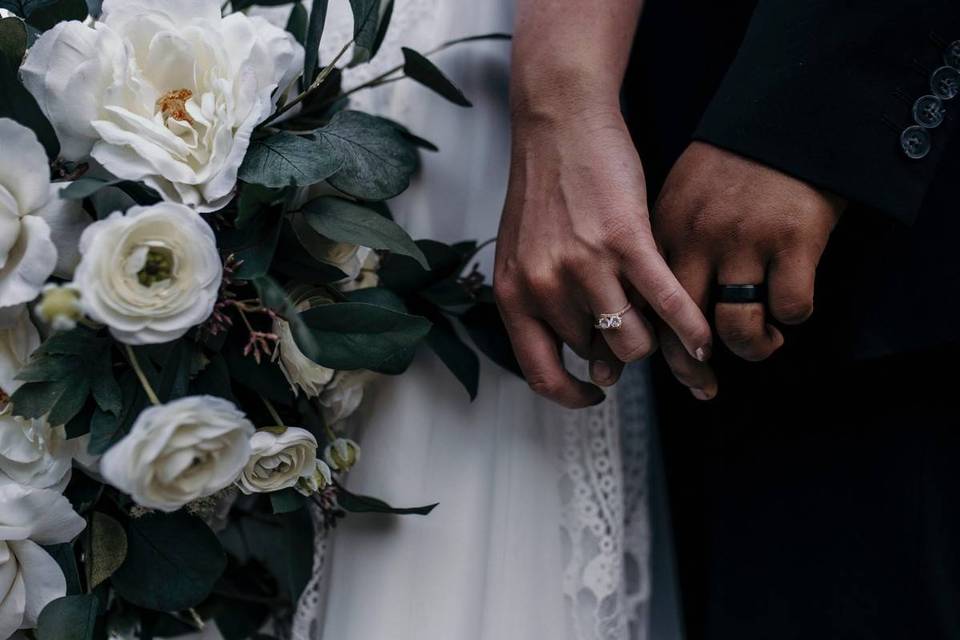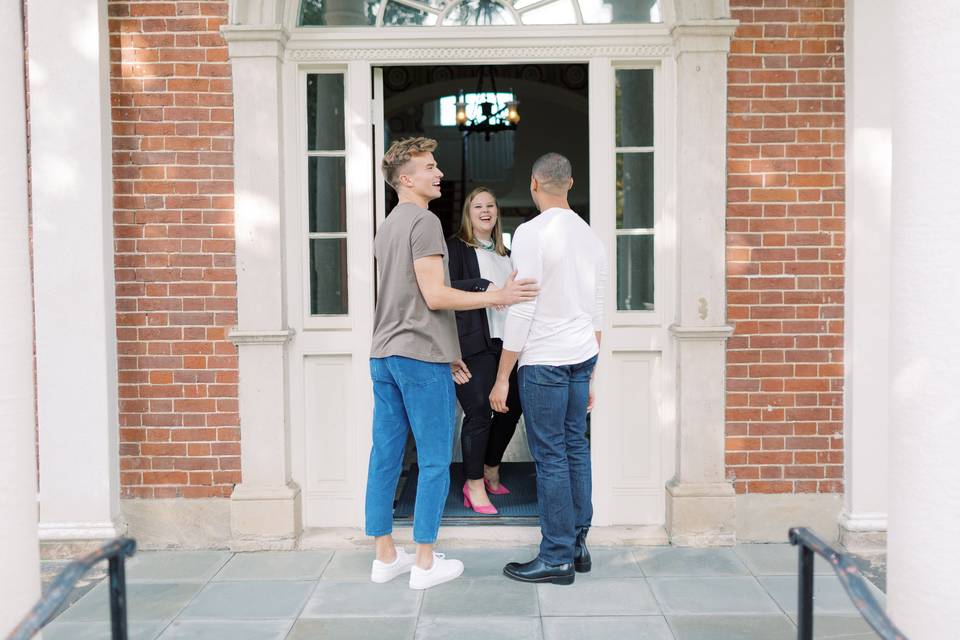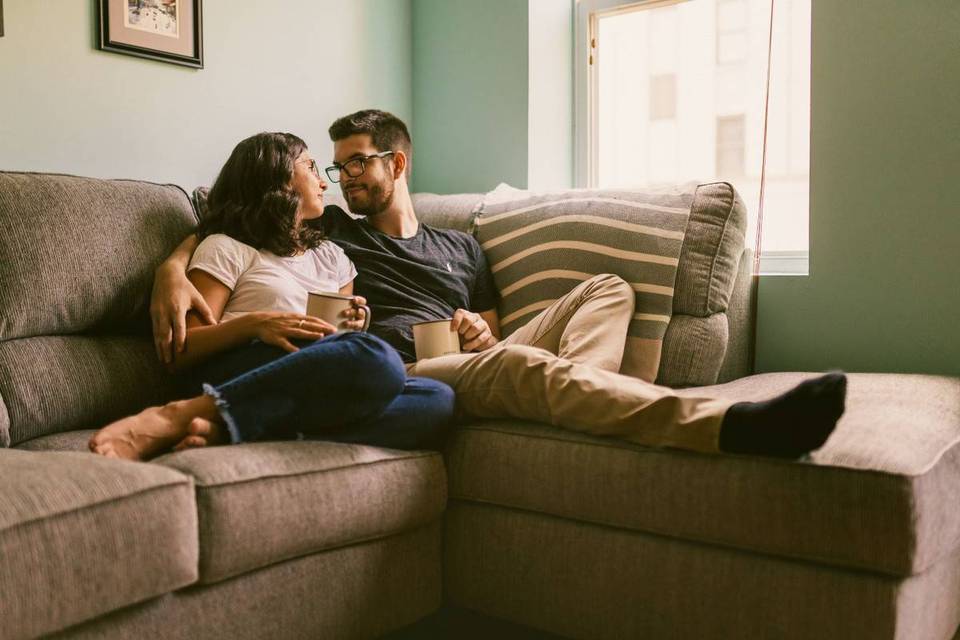The 8 Details That Will Make All the Difference for Your Virtual Wedding
Before you press that red 'record' button, follow these tips and tricks to ensure that your virtual wedding looks amazing and goes off without a glitch.
We have included third party products to help you navigate and enjoy life’s biggest moments. Purchases made through links on this page may earn us a commission.

With the COVID-19 pandemic preventing in-person weddings until further notice, many couples have turned to virtual celebrations instead. If you've decided to host an online wedding, congratulations! Even though your friends and family may not be able to attend in person, livestreaming your civil ceremony or commitment ceremony is still an incredibly special way to share the moment with everyone you love. Some states, including New York, Colorado, parts of Ohio, and Washington, D.C., have even changed their marriage license requirements to allow couples to digitally obtain legal wedding paperwork while county clerk offices are closed. But before you start streaming, there are a couple of things we recommend considering first.
Here are eight things you can do to ensure that your virtual wedding is a success.
Test your internet connection.
More than anything, you’ll want to focus on making sure your internet connection is strong, because without it, there will be no wedding livestream. Start by running internet speed and connection tests a couple of days before your virtual wedding—this will give you time to resolve any major issues if something comes up. Most tests can be performed simply by logging into your internet service provider account and reviewing your network settings. Be sure to test the internet connection on the actual device you’re planning to use for your virtual wedding. It’s also a good idea to make sure the device software is up-to-date, which can help you avoid connection issues.
Take stock of the areas in your home where the wifi connection is spotty. Avoid using these spaces for your virtual wedding or consider using a wired connection instead, which will ensure a more stable signal no matter where you are. If you do lose your connection during the livestream, just roll with it and do your best—your guests will be more than understanding!
Clean up your space.
This probably goes without saying, but we don’t recommend hosting your virtual wedding in a cluttered environment. Choose a spot in your home (or yard) to use for your virtual wedding and spend some time tidying up the space. That means vacuuming, dusting, gardening, getting rid of miscellaneous items, and even wiping down the walls if you’re using them as a backdrop. It’s important to see exactly how your space will look on camera before the big day, so once you’ve decided which location and device you’re using for the livestream, take turns doing video run-throughs with your partner.
You might be wondering why you should bother cleaning if no one is coming over, and we get it! But by showing your space a little extra love, you’ll subconsciously feel more calm, organized, and in control—all of which will boost your mood and help you get even more excited about your virtual wedding. And if nothing else, remember that some of your guests may be planning to watch your wedding on their high-definition televisions and projection screens (a.k.a. the last place you want a messy house to be exposed!).

Style your backdrop.
Styling your virtual wedding backdrop isn’t just about tidying up, it’s also about staging the area with decor that is thought-out and appropriate for the occasion. This can be as simple as using plants, candles, string lights, balloons, or other items you already have on hand at home. A pair of end tables is perfect for creating a makeshift altar—place one on each side of your backdrop and decorate accordingly. If you have a few weeks’ worth of lead time, consider purchasing a personalized backdrop to hang on the wall.
Use the right equipment.
When possible, use a newer device with an updated camera for the best video quality. If you’re streaming from a phone or a tablet, it might be worth investing in an adjustable stand that will keep your device stable and hands-free. You can also experiment with different table heights or create a makeshift stand using items you already have in your house—just be careful not to block the camera and the speakers! Record a practice video to test the sound quality, so you’ll know exactly how close you need to be in order for your guests to hear you on camera. Last but not least, make sure the battery is fully charged before you go live.
Pay attention to lighting.
Whether you’re using Google Hangouts, Zoom, FaceTime, or Facebook Live (more on the perks of each one here), most livestreaming platforms will slightly distort the quality of your video no matter what, especially if there are dozens of viewers on the call. Because of this, it’s extremely important to make sure that you’re hosting your virtual wedding in a well-lit space, which will make it much easier for everyone to see you on camera. Natural light is always more flattering than fluorescent and incandescent light, because of the way it gives makeup and skin a softer, glowing appearance. For a daytime ceremony, we recommend standing against a wall that’s directly across from a window to maximize sunlight without creating shadows. Avoid standing with the window behind you, which will create a backlit effect and make it difficult to achieve a clear picture on screen. Think of it like this:
- Do: window–camera–you
- Don’t: window–you–camera
If you don’t have a backdrop with a window or you’re hosting your ceremony at night, you can use floor lamps and other light sources from around your home to recreate the same effect. When in doubt, a multi-setting ring light will do the hard work for you while making you look fabulous.
Don’t forget about time zones.
Depending on where most of your guests will be tuning in from, you may have to plan a time that works across multiple time zones—for example, late afternoon on the East Coast to accommodate for mid-morning on the West Coast. When sending your virtual wedding invite or updating your wedding website, it can be a nice gesture to include a short note about multiple time zones so there’s no confusion. For example:
“We’ll be saying ‘I Do’ at 3 p.m. EST, 12 p.m. PST! Hope you can join us!”
Provide written instructions for your guests.
Many people (especially parents and grandparents) are figuring out how to use Zoom and Google Hangouts for the first time ever. You can save everyone a bit of trouble by providing these guests with clear, detailed instructions explaining how to do things such as join a video call, mute their microphone, or turn the camera on/off—screenshots are also a huge help! If you have time, it’s a nice gesture to do a practice call with your technologically-challenged guests before your actual wedding so they’ll feel more confident tuning in when the big day comes.
Save the recording.
We recommend saving the recording of your virtual wedding for a few reasons. First, it will come in handy if any of your guests were unable to make the original viewing time or if they experienced technical difficulties and missed part of the livestream. More importantly, the video will become a wedding keepsake that you can watch anytime you and your partner want to relive the memories.
Disclosure: This post contains affiliate links, some of which may be sponsored by paying vendors.





